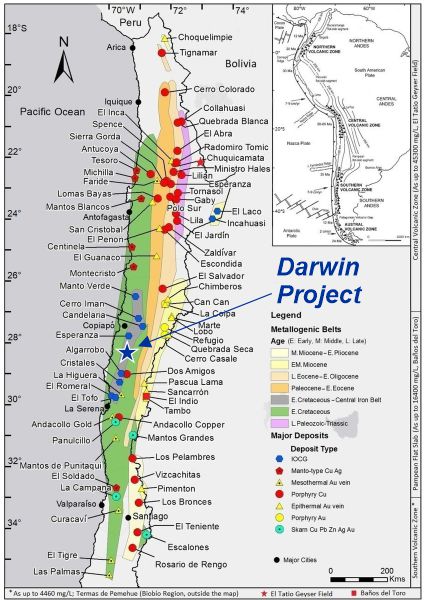Darwin
The Darwin Project in Chile lies within one of the World’s largest IOCG (iron oxide, copper, gold) Belts which includes the 1.2 Bt @ 0.60% Cu, 0.13 g/t Au, 2.0 g/t Ag Candelaria Deposit. The region is host to numerous world class copper deposits and gold rich IOCG deposits such as Carola (10Mt @ 1.8% Cu, 0.5g/t Au)2 and Atacama Kozan (50Mt @ 1.6% Cu, 0.35g/t Au).
Lodestar has secured over highly prospective 5,800-hectare project located 75 km southwest of the Mining city of Copiapó, in Region III of northern Chile. The Project is vastly underexplored with multiple historical workings across the project area which have never been sampled or drilled. The limited amount of geophysics show the presence of multiple large magnetic anomalies with the potential to define IOCG and Porphyry style mineralisation at depth.
 Figure 1: Darwin Project location in relation to other IOCG and Porphyry deposits
Figure 1: Darwin Project location in relation to other IOCG and Porphyry deposits
The association between high-grade Cu, Au and Fe at surface in the Darwin Project is very encouraging and a good indication of the project’s potential.
Very high-grade historical samples
Several rock chip sampling programmes have been completed by Coastal Metals Chile. Lodestar has also
confirmed the high Au and Cu grades with a site visit and a limited rock chip sampling programme
and assaying (Figures 2) with rock chip assays up to 247 g/t Au, 8% Cu and 66% Fe
Very high-grade Cu-Au mineralisation from rock chip samples including:
Gold : 247 g/t Au, 229 g/t Au, 195 g/t Au, 185 g/t Au, and 166 g/t Au
Copper: 8.09% Cu, 7.78% Cu, 4.75% Cu, 3.43% Cu, 3.34% Cu and 3.14% Cu
Extensive iron ore mineralisation grading above 66% Fe in outcrops
 Figure 2 : Rock chip assays on top of magnetic surveys (tmirtp hvd)
Figure 2 : Rock chip assays on top of magnetic surveys (tmirtp hvd)
Aeromagnetic surveys
Two drone aeromagnetic surveys have been flown over the Darwin and Three Saints Projects. The surveys were carried out between the months of March and May 2023 and consisted in recording earth magnetic
field anomalies using unmanned drones, initially flying E-W lines spaced at 100m and control lines
N-S direction every 1000 m, followed by one detailed area with E-W lines spaced at 25m and control
lines N-S direction every 240m.
The surveys delineated numerous magnetic anomalies, some of which are coincidental with
significant Au, Cu and Fe rock chip assays (Figure 2). Most of the magnetic anomalies however are
yet to be investigated on the ground for potential mineralisation.
The surrounding infrastructure for the Darwin project includes:
- Sealed access road crossing the tenement
- 20 km from the main highway, Ruta 5, with high voltage electricity running along the highway
- 75 km southwest of a large mining hub, the city of Copiapó, in Region III, the main mining district of Chile
- 30 km to the sea & 90 km north of the industrial port of Huasco
- In the Coastal Mountain Range, a low altitude range with access all year long
The maiden RC drilling programme was completed at Darwin in Q2 2025, comprising 16 holes for 2026m
- Significant results included:
- 8m @ 0.56 g/t Au from 96m in LDARC009
- 4m @ 0.39 g/t Au from 32m in LDARC014
- 1m @ 0.68 g/t Au from 35m in LDARC010
- 2m @ 0.48 g/t Au & 0.51% Cu from 30m in LDARC007
- The results confirmed geological potential of Darwin and provide a strong technical foundation for the next phase of exploration.

